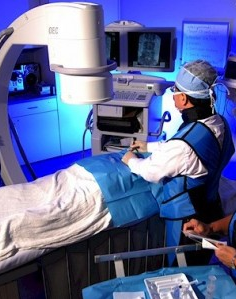 Millions of Americans suffer from chronic back pain; many of these people are prescribed opioid analgesics to manage their pain to help them function. For many of these patients even strong opioids are not sufficient to relieve their pain, and so they undergo a procedure called a selective nerve root block. This procedure is performed as both a diagnostic procedure as well as a pain management procedure.
Millions of Americans suffer from chronic back pain; many of these people are prescribed opioid analgesics to manage their pain to help them function. For many of these patients even strong opioids are not sufficient to relieve their pain, and so they undergo a procedure called a selective nerve root block. This procedure is performed as both a diagnostic procedure as well as a pain management procedure.
In the selective nerve root block procedure, the Arizona workers compensation pain physician injects a mixture of local anesthetics and corticosteroid at the nerve root where it exits the foramen (small hole through which the nerve root passes) of the vertebrae. The first injection is considered to be diagnostic; if the pain stops then a correct diagnosis has been made and further injections to the same nerve root will be made to prolong the pain relief.
The procedure is performed as an outpatient procedure; the patient is placed face down on the exam table and the area to be injected is thoroughly cleansed with an antiseptic solution to minimize the risk of infection. The skin of area to be injected is numbed with a topical anesthetic and then a very fine needle is inserted under fluoroscope guidance (a fluoroscope is a type of x-ray machine that allows the Phoenix work comp doctor to see a live image of the needle to ensure proper placement), and then a contrast dye is injected to ensure the  medication will cover the nerve that is intended to be treated.
medication will cover the nerve that is intended to be treated.
After proper placement has been assured by the dye, the doctor will then slowly inject a mixture of local anesthetics and corticosteroids into the area. The patient will often experience immediate relief from the effects of the local anesthetic as it will numb the nerve right away. If relief is felt then a correct diagnosis has been made and the correct nerve root has been treated. The effects of the local anesthetic usually wear off within a few hours and then it may take twenty four to forty eight hours for the corticosteroid to begin to have an effect.
Once the corticosteroid begins to provide relief it may last for several days or up to several weeks with the first injection treatment. It often requires several treatments before the  corticosteroid provides the maximum benefit, but once maximum benefit has been achieved the pain relieving effects can last for several months or in some cases as long as a year.
corticosteroid provides the maximum benefit, but once maximum benefit has been achieved the pain relieving effects can last for several months or in some cases as long as a year.
The level of relief each patient experiences cannot be anticipated as it is dependent upon how well they react to the medications used. Side effects and risks to this procedure are minimal but can include slight bruising or bleeding from the injection site. Risk of infection is minimal as long as the area injected is kept clean until it heals, usually within a few days.






Leave A Comment